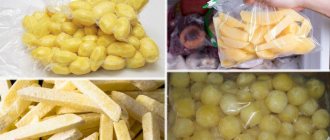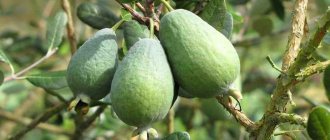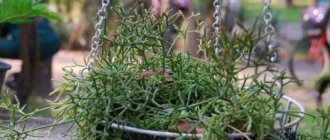Feijoa - what is it and what is it eaten with? Is this a vegetable or a fruit? What does it taste like? This is how the majority of people in our country will react. Is this fruit name exotic to you? It is not surprising, because South America is considered the birthplace of this fruit, so in Russia this name remains mysterious and enigmatic. However, in Europe and the USA, this tasty and healthy fruit has won more than one million fans. Let's figure out what feijoa is, what it tastes like, how to eat it, and what its beneficial properties are.
You will learn everything about this wonder from our article.
Feijoa fruit is rich in vitamins and microelements . This is an additional source of iodine for our body, and this berry also contains manganese, iron, phosphorus, zinc, potassium and other useful trace elements. This exotic wonder is rich in vitamin C, so it will help cope with viral diseases in autumn and winter.
What it is
Feijoa (Feijoa sellowiana), or Akka, is an evergreen shrub or tree belonging to the Myrtaceae family. It grows wild in subtropical regions of South America.
Since the beginning of the 20th century, it has been cultivated in almost all regions with a subtropical climate, including the Caucasus and Crimea, but industrial plantings can be found mainly in Australia and New Zealand.
The plant is used as an ornamental, food and medicinal plant. Feijoa fruits are eaten as food - large, fleshy berries weighing 15-60 g (in some varieties up to 120 g).
The flowers are beautiful, with dark pink fleshy petals and long bright red stamens with yellow anthers at the ends. A person far from botany can easily mistake a photo of a feijoa flower for a fuchsia houseplant.
Flowers bloom in May and are pleasing to the eye throughout the month. Pollinating insects are necessary for fruit set, although self-fertile varieties are also known. As a rule, only 15-20% of the ovaries bear fruit.
INTERESTING ! The flower petals are also edible and have a pleasant sweet taste.
Feijoava Kurd
Curd is a type of English dessert - custard to which berries, juices, eggs and butter are added. Take 100 grams of feijoa, wash and cut off the very edges. Squeeze juice from lemon. Place exotic fruits in a blender bowl and grind until pureed. Break 2 eggs there, add 3 tbsp. spoons of granulated sugar, pour in ½ of the resulting lemon juice. Beat.
Keep 30 g of butter at room temperature until it becomes soft in a vessel in which the curd will then be cooked. Place on low heat. Add the mixture from the blender bowl there. Cook for a short time until it thickens. Cool. Serve in thick glass glasses.
Feijoa is an excellent remedy for the prevention of many diseases, as well as for clarity in the head, peace in the heart, and vigor and a “fighting” spirit in the soul. We hope that our recipes will take their rightful place in your family cookbook. Bon appetit!
When is the season and price
Feijoa fruits appear on sale from mid-September and can be found right up to January. The peak season is in October-November. The first fruits of early varieties ripen in September, but mass harvesting does not begin until October.
The berries do not ripen at the same time, so they have to be picked selectively in several stages. Ripe fruits fall off, although they remain dense and slightly damaged. Ripening occurs during storage.
Even harvested from a bush on time in a refrigerator cannot be stored for more than 2-4 weeks, so the season is short. To preserve the harvest, the fruits are actively used in home preparations.
The price of fresh berries depends on the country of origin and the quality of the product. Fruits grown in Abkhazia, Azerbaijan or Georgia cost from 100 rubles. for 1 kg, while they are not calibrated and have a dense peel.
On average, the market price for a suitable product is 180-200 rubles per 1 kg. (usually more expensive at the beginning of the season).
Application for men
The beneficial properties for men when consuming feijoa fruit are priceless:
- Prostatitis. Feijoa fruits should be consumed for its prevention and treatment.
- Prostate adenoma and its prevention. The oncoprotective properties of berries will be useful in these cases.
- Hormonal therapy. In case of problems with the opposite sex, it increases libido.
- Infertility. Berries improve the functioning of the reproductive system.
Feijoa is a beneficial fruit in many respects in terms of health, so it should definitely be present in a man’s diet.
How to choose
When choosing feijoa, it is important to pay attention to:
- integrity - there should be no damage;
- color - bright green (color distributed evenly).
It is better to take fruits that are medium soft to the touch; hard ones may turn out to be unripe (they will have to ripen in a warm (room temperature) dark place, literally 2 days).
Note: in terms of size, focus on medium-sized specimens; it is better not to buy either small or too large.
Exotic candied fruits
In addition to drinks, filling for pies, pureed feijoa pulp with nuts - an excellent dessert for tea, muffins and cupcakes, candied fruits are also made from these green “vitamins”. Wash the feijoa, remove the peel and cut into slices. Boil the syrup: water and sugar in equal proportions, and add slices of exotic fruits into it. Let them stand for half an hour. And then spread all this “delight” in an even layer on a parchment baking sheet and put it in the oven set to 120 ° C. After 2 hours, turn off the oven, remove the baking sheet and leave to cool. Cut into small pieces of any shape and roll in powdered sugar.
How to eat fruit
There are different options for using the product. The greatest benefit for the body will come from eating fresh fruits, but due to the short shelf life, other methods must be used.
- Whole fresh
The berries are washed well, peeled and eaten with the peel. If desired, you can pre-dose the berries with boiling water.
ON A NOTE! It is the peel that contains a high concentration of beneficial microelements, including iodine.
- Peeled, without peel
The skin has a tart taste and a rough texture, in contrast to the tender pulp, so the washed berries are cut into 2 halves and the pulp is scooped out using a small spoon. You can also simply peel the berries with a knife.
- Smoothies and milkshakes
Feijoa pulp is mixed with other fruits (for example, banana) and beaten in a mixer with apple juice or milk.
- Puree
The peeled pulp or peeled fruits are crushed and then used to prepare desserts (fillings for confectionery, marmalade, jellies, jams, preserves).
- Ice cream, popsicles or sorbet
Frozen feijoa desserts are exotic in the middle zone, but in Georgia ice cream with feijoa pieces is a common and popular delicacy.
- Fruit salads
Feijoa in combination with other fruits can become a healthy and tasty dessert.
- Vegetable salads
Peeled feijoa pulp goes well with beets, fennel, lettuce, sweet peppers, cucumber, nuts and cheese, and thinly sliced peel is added to traditional vegetable salads to add piquancy.
- Drying
You can dry the peel left after peeling the pulp. It is rich in essential oils, which give the fruit a special aroma, and is used to flavor drinks (tea, lemonade, compote) or baked goods.
- Sweet preparations
The berries are used both for making traditional jam and raw jam. The fruit goes well with citrus fruits (lemon, orange) and herbs (oregano, sage).
- Beverages
The simplest feijoa drink is compote. It is boiled during the fresh fruit season and preserved for the winter. The berry goes well with other fruits, such as apples, quince, and citrus fruits.
- Alcoholic drinks
The fruits are used to make aromatic tinctures, wine, or added to cocktails based on sparkling wines or champagne.
IMPORTANT: Excessive alcohol consumption is harmful to your health.
- Sauce
Recently, berry sauces for meat dishes have become popular. The sweet and sour taste of the berries goes well with hot seasonings and spices, which is why feijoa is used to make chutney.
Meat salad
Feijoa goes well with meat, chicken and fish. To make a meat salad with assorted fruits and vegetables, you need to tinker. Take pork without fat, wash, cut into thin strips and fry in a frying pan in vegetable oil along with finely chopped onions. Add chopped feijoa, soy sauce and 2-3 tablespoons of red wine to the pan. Cut the red bell pepper into thin pieces and add to our “salad”. Add chopped cashews there. After 3 minutes, remove the frying pan and place it in a salad bowl, where a mix of different salads, torn by hand into pieces, is already “waiting.” Mix the salad with two forks and pour low-fat yogurt into it. You can serve!
Beneficial features
IMPORTANT: first of all, feijoa is just a product that cannot replace full treatment at home or in a hospital if necessary. Under no circumstances should you use the fruit for therapeutic purposes on your own. If you have real health problems, consult a specialist, a doctor (in person!).
Composition per 100 g (nutritional value):
- proteins - 0.75 g;
- fats - 0.5 g;
- carbohydrates - 8.75 g.
Lots of iodine, silicon, cobalt, chromium (microelements), and vitamin C.
Number of calories: 61/100 g.
The rich chemical composition, the presence of water-soluble iodine compounds in huge quantities (comparable to seafood), as well as a large amount of vitamin C make the fruits unique.
Useful properties can be grouped into several points:
- Improves digestion;
- Is a source of available iodine;
- Reduces cholesterol levels;
- Removes heavy metals;
- Strengthens the immune system;
- Shows antioxidant activity.
And, of course, what other benefits does the berry have for humans? It replenishes iodine deficiency.
Is it necessary to peel feijoa before grinding and eating?
One of the main questions that people face is “How to eat feijoa with the peel or not?” Despite the fact that the taste of the fruit peel is quite specific, and some people may not like it, there is nothing harmful in it.
The fruit itself should not be processed, as when boiled the fruit becomes softer.
It is also endowed with its beneficial properties; it contains antioxidants that help slow down the aging process, lower cholesterol levels, prevent vision loss and resist the development of certain forms of cancer.
The fruit retains its beneficial qualities only for a week.
Hence the conclusion: there is no question of the need to clean the feijoa, if the taste of the peel seems completely unbearable, then it is recommended to peel it, dry it, grind it in a blender and add tea, the taste of which will not change, it will only add aroma.
It is worth noting that the fruits of this plant will not only diversify your menu, but will also become a table decoration.
Contraindications and harm
Contraindications:
- Individual intolerance to the product or allergy to it.
- The fruit should not be consumed by people suffering from hyperthyroidism (hyperthyroidism).
- Limit in case of pancreatitis and gastritis with high acidity (under the supervision of a specialist).
- Patients with diabetes can eat fruits only fresh, without adding sugar or even honey (taking into account bread units).
Harm is possible with excessive consumption of feijoa and is expressed by the following symptoms:
- increased nervous excitability;
- anxiety;
- irritability;
- arrhythmia;
- fluctuations in body temperature.
Iodine "bomb"
Let us remind you that the daily amount of iodine in the body of an adult should not be lower than 150 mcg. And we get this unique substance from the outside, that is, from food. The minimum percentage of iodine is found in eggs, milk, fish, seafood, water, cereals, vegetables and fruits. But feijoa is a storehouse of not only iodine, but also other useful substances, such as:
- Organic acids: malic, folic;
- Microelements: calcium, sodium, phosphorus, magnesium, potassium, iron, etc.;
- Essential oils;
- Vitamins: C, group B, PP.
The pulp of the fruit is easily absorbed by the body, and it is also low in calories. That is why the use of feijoa is recommended for people who are obese, as well as those who are on diets. But this wonderful berry will not harm others, but will replenish the deficiency of vitamins and beneficial elements.
So, the green feijoa fruits, inconspicuous at first glance, remained for a long time in the “shadow” of the dense bushes on which they grew. Until one day the naturalist and naturalist João da Silva Feijó stumbled upon them. A strange but very tasty fruit of the Myrtaceae family was named after his last name.
According to legend, the king of the seas wrapped a young man in love with his daughter in a beautiful low-growing tree with juicy and healthy fruits. And that tree grew near the sea, and its small green “berries” carried the aroma of the sea breeze.
Raw jam
So, feijoa, how is it eaten and in what form? For starters, you can try jam from this fruit. The fruits should be crushed to a pulpy state. This can be done using a blender or a meat grinder. However, you should not remove the peel, as it contains a huge amount of vitamins. The resulting mass must be mixed with sugar. You will get simply amazing jam without cooking. For 1 kilogram of feijoa you need 1 kilogram of sugar. When the jam is ready, you can put it in pre-sterilized jars. It is better to store the finished product in the refrigerator. You can also add crushed hazelnuts or walnuts to the mixture.











